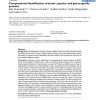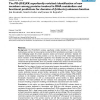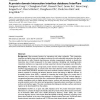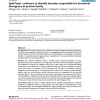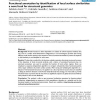BMCBI
2005
13 years 4 months ago
2005
Background: The identification of unique proteins at different taxonomic levels has both scientific and practical value. Strain-, species- and genus-specific proteins can provide ...
BMCBI
2005
13 years 4 months ago
2005
Background: The majority of residues in protein structures are involved in the formation of helices and -strands. These distinctive secondary structure patterns can be used to rep...
BMCBI
2005
13 years 4 months ago
2005
Background: The sequencing of the human genome has enabled us to access a comprehensive list of genes (both experimental and predicted) for further analysis. While a majority of t...
BMCBI
2005
13 years 4 months ago
2005
Background: Recognition codes for protein-DNA interactions typically assume that the interacting positions contribute additively to the binding energy. While this is known to not ...
BMCBI
2005
13 years 4 months ago
2005
Background: Current protein clustering methods rely on either sequence or functional similarities between proteins, thereby limiting inferences to one of these areas. Results: Her...
BMCBI
2005
13 years 4 months ago
2005
Background: The PD-(D/E)XK nuclease superfamily, initially identified in type II restriction endonucleases and later in many enzymes involved in DNA recombination and repair, is o...
BMCBI
2005
13 years 4 months ago
2005
Background: Normal mode analysis (NMA) has become the method of choice to investigate the slowest motions in macromolecular systems. NMA is especially useful for large biomolecula...
BMCBI
2005
13 years 4 months ago
2005
Background: Most proteins function by interacting with other molecules. Their interaction interfaces are highly conserved throughout evolution to avoid undesirable interactions th...
BMCBI
2005
13 years 4 months ago
2005
Background: Many protein families have undergone functional divergence after gene duplications such that current subgroups of the family carry out overlapping but distinct biologi...
BMCBI
2005
13 years 4 months ago
2005
Background: Protein function is often dependent on subsets of solvent-exposed residues that may exist in a similar three-dimensional configuration in non homologous proteins thus ...
